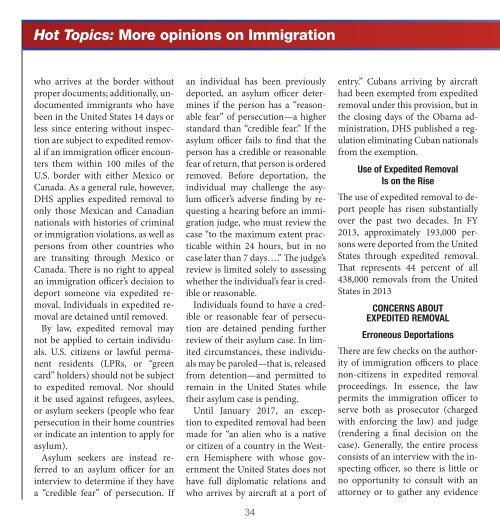Government Security News February 2017 Digital Edition
You also want an ePaper? Increase the reach of your titles
YUMPU automatically turns print PDFs into web optimized ePapers that Google loves.
Hot Topics: More opinions on Immigration<br />
who arrives at the border without<br />
proper documents; additionally, undocumented<br />
immigrants who have<br />
been in the United States 14 days or<br />
less since entering without inspection<br />
are subject to expedited removal<br />
if an immigration officer encounters<br />
them within 100 miles of the<br />
U.S. border with either Mexico or<br />
Canada. As a general rule, however,<br />
DHS applies expedited removal to<br />
only those Mexican and Canadian<br />
nationals with histories of criminal<br />
or immigration violations, as well as<br />
persons from other countries who<br />
are transiting through Mexico or<br />
Canada. There is no right to appeal<br />
an immigration officer’s decision to<br />
deport someone via expedited removal.<br />
Individuals in expedited removal<br />
are detained until removed.<br />
By law, expedited removal may<br />
not be applied to certain individuals.<br />
U.S. citizens or lawful permanent<br />
residents (LPRs, or “green<br />
card” holders) should not be subject<br />
to expedited removal. Nor should<br />
it be used against refugees, asylees,<br />
or asylum seekers (people who fear<br />
persecution in their home countries<br />
or indicate an intention to apply for<br />
asylum).<br />
Asylum seekers are instead referred<br />
to an asylum officer for an<br />
interview to determine if they have<br />
a “credible fear” of persecution. If<br />
an individual has been previously<br />
deported, an asylum officer determines<br />
if the person has a “reasonable<br />
fear” of persecution—a higher<br />
standard than “credible fear.” If the<br />
asylum officer fails to find that the<br />
person has a credible or reasonable<br />
fear of return, that person is ordered<br />
removed. Before deportation, the<br />
individual may challenge the asylum<br />
officer’s adverse finding by requesting<br />
a hearing before an immigration<br />
judge, who must review the<br />
case “to the maximum extent practicable<br />
within 24 hours, but in no<br />
case later than 7 days….” The judge’s<br />
review is limited solely to assessing<br />
whether the individual’s fear is credible<br />
or reasonable.<br />
Individuals found to have a credible<br />
or reasonable fear of persecution<br />
are detained pending further<br />
review of their asylum case. In limited<br />
circumstances, these individuals<br />
may be paroled—that is, released<br />
from detention—and permitted to<br />
remain in the United States while<br />
their asylum case is pending.<br />
Until January <strong>2017</strong>, an exception<br />
to expedited removal had been<br />
made for “an alien who is a native<br />
or citizen of a country in the Western<br />
Hemisphere with whose government<br />
the United States does not<br />
have full diplomatic relations and<br />
who arrives by aircraft at a port of<br />
34<br />
entry.” Cubans arriving by aircraft<br />
had been exempted from expedited<br />
removal under this provision, but in<br />
the closing days of the Obama administration,<br />
DHS published a regulation<br />
eliminating Cuban nationals<br />
from the exemption.<br />
Use of Expedited Removal<br />
Is on the Rise<br />
The use of expedited removal to deport<br />
people has risen substantially<br />
over the past two decades. In FY<br />
2013, approximately 193,000 persons<br />
were deported from the United<br />
States through expedited removal.<br />
That represents 44 percent of all<br />
438,000 removals from the United<br />
States in 2013<br />
CONCERNS ABOUT<br />
EXPEDITED REMOVAL<br />
Erroneous Deportations<br />
There are few checks on the authority<br />
of immigration officers to place<br />
non-citizens in expedited removal<br />
proceedings. In essence, the law<br />
permits the immigration officer to<br />
serve both as prosecutor (charged<br />
with enforcing the law) and judge<br />
(rendering a final decision on the<br />
case). Generally, the entire process<br />
consists of an interview with the inspecting<br />
officer, so there is little or<br />
no opportunity to consult with an<br />
attorney or to gather any evidence















